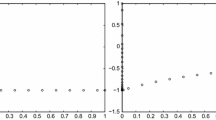Abstract
We describe a computational procedure designed to automatically analyze the behavior of certain general classes of nonlinear singular perturbation problems by applying the combined results of a body of theory that proves the existence of solutions for these problems. We have also created a computer program that implements the computational procedure. The core mathematical knowledge contained in our program is composed of rules that embody the results of mathematical theorems from nonlinear singular perturbation theory. The principle method of proof used in the mathematical theory yields an estimate of a solution by constructing sharp bounding functions that define a region in which the solution exists uniquely. As a result, a successful application of our program produces an approximation of a solution as a side effect. In addition, the mathematical theory can be used to show the existence of multiple solutions for a nonlinear singularly perturbed boundary value problem. This feature is also reflected in the results obtained from our program. The ability to construct such a program depends critically on the successful coupling of a non-deterministic programming technique called path-finding with the capabilities of a computer algebra system.
Similar content being viewed by others
References
ChangK. W. and HowesF. A.Nonlinear Singular Perturbation Phenomena: Theory and Applications. Springer-Verlag, New York (1984).
JacksonL. K. ‘Subfunctions and second-order differential inequalities’.Advances in Math. 2, 307–363 (1968).
NagumoM., ‘Uber di Differentialgleichungy″=f(x, y, y′)’.Proc. Phys. Math. Soc. Japan 19, 861–866 (1937).
ChinR. C. Y., HedstromG. W., HowesF. A. and McGrawJ. R. ‘Parallel computation of multiple-scale problems’.New Computing Environments: Parallel, Vector and Systolic, A.Wouk, ed., SIAM, Philadelphia, Pa. (1986).
Scroggs, J. S. ‘The solution of a parabolic partial differential equation via domain decomposition: the synthesis of asymptotic and numerical anlaysis’. Doctoral Dissertation, University of Illinois at Urbana-Champaign, May (1988).
Scroggs, J. S. ‘Parallel computational of a domain decomposition method’.Proceedings of the Third SIAM Conference on Parallel Processing for Scientific Computing, Los Angeles, CA. (1987).
HedstromG. W. and HowesF. A. ‘A domain decomposition method for a convection diffusion equation with turning point’.Domain Decomposition Methods, (T. F.Chan, R.Glowinski, J.Periaux and O. B.Widlund, eds.), SIAM, Philadelphia, Pa. (1989).
Russo, M. F. ‘Automatic generation of parallel programs using nonlinear singular perturbation theory’, Doctoral Dissertation, Dept. of Chemical and Biochemical Engineering, Rutgers University, New Brunswick, N.J., May (1989).
ClocksinM. F. and MellishC. S.Programming in Prolog. Springer-Verlag, New York (1981).
SterlingL. and ShapiroE.The Art of Prolog, Advanced Programming Techniques. The MIT Press, Cambridge, Mass. (1986).
CharB. W., GeddesK. O., GonnetG. H. and WattS. M.Maple User's Guide. WATCOM Publications Limited, Waterloo, Ontario (1985).
NilssonN. J.Principles of Artificial Intelligence. Morgan Kaufmann Publishers, Inc., Los Altos, California (1980).
HowesF. A. ‘Multi-dimensional initial-boundary value problems with strong nonlinearities’.Archive for Rational Mechanics and Analysis 91, 153–168 (1986).
O'DonnellM. A. ‘Boundary and corner layer behavior in singularly perturbed semilinear systems of boundary value problems’.SIAM J. of Math. Anal. 15, 317–332 (1984).
BurgersJ. M. ‘Mathematical model illustrating the theory of turbulence’.Trans. Roy. Neth. Acad. Sci. 17, 1–53 (1939).
Howes, F. A. ‘Differential Inequality Techniques and Singular Perturbations’.Rocky Mountain Journal of Mathematics 12 (1982).
ProtterM. H. and WeinbergerH. F.Maximum Principles in Differential Equations. Springer-Verlag, New York (1984).
Howes, F. A.Boundary-Interior Layer Interactions in Nonlinear Singular Perturbation Theory. Memoirs of the American Mathematics Society, No. 203, Vol. 15 (1978).
HeidelJ. W. ‘A second-order nonlinear boundary value problem’.J. Math. Anal. and Appl. 48, 493–503 (1974).
FlahertyJ. E. and O'MalleyR. E.Jr. ‘Numerical methods for stiff systems of two-point boundry value problems’,SIAM J. Sci. Stat. Comput. 5, 865–886 (1984).
Russel, R. D. and Christiansen, J. ‘Adaptive Mesh Selection Strategies for Solving Boundary Value Problems’.SIAM Journal of Numerical Analysis 15 (1978).
Chin, R. C. Y., Hedstrom, G. W. ‘Considerations on solving problems with multiple scales’.Multiple Time Scales (Brackbill and Cohen, eds.) (1985).
Author information
Authors and Affiliations
Additional information
The research reported here was supported in part by the National Science Foundation under NSF Grant EE-14937, and in part by the CAIP Center, Rutgers University, with funds provided by the New Jersey Commission on Science and Technology and by CAIP's industrial members.
Rights and permissions
About this article
Cite this article
Russo, M.F., Peskin, R.L. Automatically identifying the asymptotic behavior of nonlinear singularly perturbed boundary value problems. J Autom Reasoning 8, 395–419 (1992). https://doi.org/10.1007/BF02341856
Received:
Accepted:
Issue Date:
DOI: https://doi.org/10.1007/BF02341856



